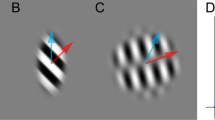Abstract
Two superimposed gratings, which differ in orientation and move independently, combine into a coherently moving plaid if the component gratings are similar. The effect on the plaid motion percept of the addition of texture to each grating was investigated. The texture disambiguates the motion of each component grating. Under the assumption of recombination of first-stage motion detectors into a second stage, which becomes available to perception, one would expect the perceived motion direction of the plaid to change as a result of texture addition. Subjects perceived the oblique motion direction of textured bars of a single orientation correctly. This occurred for texture details with dimensions down to the resolution limit in the fovea (1 min of arc). Two bar patterns with fine texture (1 min of arc details) which differ in orientation were perceived to cohere into a plaid. The plaid's motion direction, however, was independent of the parallel motion components of the bars. For coarser textures (2 and 4 min of arc details) the bar patterns were perceived to slide past one another. In addition, we found that the plaid motion percept occurred less frequently for longer motion sequences, wider bars and for a combination of the component textures at the intersections which is compatible with partial transparency of the bars. These results do not support the two-stage model of Adelson and Movshon (1982), where only the motion component perpendicular to each grating orientation is encoded and where the perception of the plaid motion results from “recombination” of these perpendicular motion components. The data are more in line with a model where first-stage motion detectors are orientation selective but without the restriction that their preferred direction of motion is perpendicular to their preferred orientation. In the second stage it is proposed that combination occurs across the orientation dimension only. This preserves the direction of motion “labels” at the output of the second stage and allows for representation of transparent as well as coherent plaid motion at this stage of processing.
Similar content being viewed by others
References
Adelson EH, Movshon JA (1982) Phenomenal coherence of moving visual patterns. Nature 300:523–525
Adelson EH, Movshon JA (1984) Binocular disparity and the computation of two-dimensional motion. J Opt Soc Am [A]1: 1266
van den Berg AV, van de Grind WA, van Doom JA (1990) Motion detection in the presence of local orientation changes. J Opt Soc Am [A]5:933–939
van den Berg AV, van de Grind WA (1991) Conditions for the detection of coherent motion. Vision Res 31:1039–1051
Chubb C, Sperling G (1988) Drift-balanced random stimuli: a general basis for studying non-Fourier motion perception J Opt Soc Am [A]5:1986–2007
Derrington A, Suero M (1991) Motion of complex patterns is computed from the perceived motions of their components. Vision Res 31:139–149.
van Doorn AJ, Koenderink JJ (1982) Spatial properties of the visual detectability of moving spatial white noise. Exp Brain Res 45:189–195
van Doom AJ, Koenderink JJ (1983) Detectability of velocity gradients in moving random-dot patterns. Vision Res 23:799–804
Fennema CL, Thompson WB (1979) Velocity determination in scenes containing several moving objects. Comput Graph Image Proc 9:301–315
Ferrera KP, Wilson HR (1987) Direction specific masking and the analysis of motion in two dimensions. Vision Res 27:1783–1796
Ferrera KP, Wilson HR (1990) Perceived direction of moving two-dimensional patterns. Vision Res 30:273–287
Koenderink JJ, van Doom JA (1987) Representation of local geometry in the visual system. Biol Cybern 55:367375
Krauskopf J, Fareil B (1990) Influence of colour on the perception of coherent motion. Nature 348:328–331
Lelkens AMM, Koenderink JJ (1984) Illusory motion in visual displays. Vision Res 24:1083–1090
Levinson E, Sekuler R (1980) A two-dimensional analysis of direction-specific adaptation. Vision Res 20:103–107
Marshak W, Sekuler R (1979) Mutual repulsion between moving visual targets. Science 205:1399–1401
Movshon JA, Adelson EH, Gizzi M (1985) The analysis of moving visual patterns. Exp Brain Res [Suppl] 11:117–152
Murphy BJ, Kowler E, Steinman RM (1975) Slow oculomotor control in the presence of moving backgrounds. Vision Res 15:1263–1268
Noest A, van den Berg AV (1993) The role of early mechanisms in motion transparency and coherence. (Spatia Vision, in the press)
Ramachandran VS, Anstis SM (1983) Displacement thresholds for coherent apparent motion in random dot patterns. Vision Res 23:1719–1724
Rodman HR, Albright TD (1987) Coding of visual stimulus velocity in area MT of the macaque. Vision Res 27:2035–2048
Rodman HR, Albright TD (1989) Single-unit analysis of pattern-motion-selective properties in the middle temporal visual area (MT). Exp Brain Res 75:53–64
Smith AT, Edgar GK (1991) Perceived speed and direction of complex gratings and plaids. J Opt Soc Am [A]8:1161–1171
Stone LS, Watson AB, Mulligan JB (1990) Effect of contrast on the perceived direction of a moving plaid. Vision Res 30:1049–1067
Stoner GR, Albright TD, Ramachandran VS (1990) Transparency and coherence in human motion perception. Nature 344:153–155
Welch L (1989) The perception of moving plaids reveals two motion-processing stages. Nature 337:734–736
Wörgotter F, Eysel UT (1987) Quantitative determination of orientational and directional components in the response of visual cortical cells to moving stimuli. Biol Cybern 57:349–355
Wörgotter F, Muche T, Eysel UT (1991) Correlations between directional and orientational tuning of cells in cat striate cortex. Exp Brain Res 83:665–669
Zhang J (1990) How to unconfound the directional and the orientational information in visual neurons' response. Biol Cybern 63:135–142
Author information
Authors and Affiliations
Rights and permissions
About this article
Cite this article
van den Berg, A.V., van de Grind, W.A. Do component motions recombine into a moving plaid percept?. Exp Brain Res 93, 312–323 (1993). https://doi.org/10.1007/BF00228400
Received:
Accepted:
Issue Date:
DOI: https://doi.org/10.1007/BF00228400




